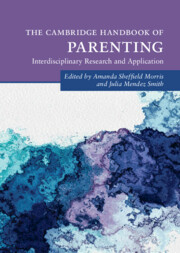Book contents
- The Cambridge Handbook of Parenting
- Cambridge Handbooks in Psychology
- The Cambridge Handbook of Parenting
- Copyright page
- Dedication
- Contents
- Contributors
- Figures
- Tables
- Introduction
- Part I Foundations of Parenting
- 1 Foundational Theories and the Establishment of Parenting Science Research
- 2 Parenting, Challenges, Brain Development, and Attachment Strategies
- 3 Parenting and Brain Development
- 4 Parenting and Children’s Social and Emotional Development: Emotion Socialization across Childhood and Adolescence
- 5 Parents Matter: The Cornerstone for Children’s Cognitive and Language Development
- 6 Discipline and Punishment in Child Development
- 7 Parenting From a Cultural and Global Perspective: A Review of Theoretical Models and Parenting Research in Diverse Cultural Contexts
- Part II Parenting across Development: Social, Emotional, and Cognitive Influences
- Part III Parental Factors That Impact Parenting
- Part IV Child Factors that Impact Parenting
- Part V Parent Education, Intervention and Policy
- Index
- References
1 - Foundational Theories and the Establishment of Parenting Science Research
from Part I - Foundations of Parenting
Published online by Cambridge University Press: 01 December 2022
- The Cambridge Handbook of Parenting
- Cambridge Handbooks in Psychology
- The Cambridge Handbook of Parenting
- Copyright page
- Dedication
- Contents
- Contributors
- Figures
- Tables
- Introduction
- Part I Foundations of Parenting
- 1 Foundational Theories and the Establishment of Parenting Science Research
- 2 Parenting, Challenges, Brain Development, and Attachment Strategies
- 3 Parenting and Brain Development
- 4 Parenting and Children’s Social and Emotional Development: Emotion Socialization across Childhood and Adolescence
- 5 Parents Matter: The Cornerstone for Children’s Cognitive and Language Development
- 6 Discipline and Punishment in Child Development
- 7 Parenting From a Cultural and Global Perspective: A Review of Theoretical Models and Parenting Research in Diverse Cultural Contexts
- Part II Parenting across Development: Social, Emotional, and Cognitive Influences
- Part III Parental Factors That Impact Parenting
- Part IV Child Factors that Impact Parenting
- Part V Parent Education, Intervention and Policy
- Index
- References
Summary
This chapter concerns two elemental aspects of parenting research: foundational theories and the establishment of research into parent-child relationships. The six essential theories that have formed the groundwork for understanding parenting are reviewed. These theories are: evolution, attachment, socialization, behavioral genetics, social cognition, and systems. While the earliest theories were developing, research into parenting began to be published. Empirical studies about child rearing appeared in journals with some regularity beginning in the 1930s. Around the same time, child study centers and the interest in child guidance and parent education emerged. Researchers into parent-child relationships have adopted different theoretical approaches, taken multiple and often dissimilar methods, and addressed diverse questions. Many of the studies can be characterized into one of eight approaches: trait, child effects and transactions, social learning, social address, social cognition, behavioral genetics, ecological momentary, and large sample, longitudinal datasets. These approaches are described and contrasted. The chapter ends with discussion of some of the current research trends.
- Type
- Chapter
- Information
- The Cambridge Handbook of Parenting , pp. 5 - 28Publisher: Cambridge University PressPrint publication year: 2022

